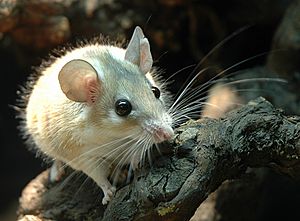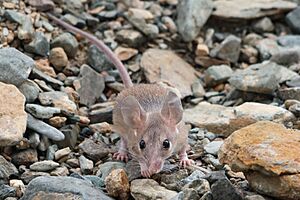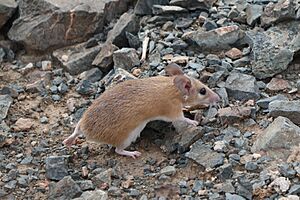Eastern spiny mouse facts for kids
Quick facts for kids Eastern spiny mouse |
|
|---|---|
 |
|
| Conservation status | |
| Scientific classification | |
| Genus: |
Acomys
|
| Species: |
dimidiatus
|
| Synonyms | |
|
Acomys cahirinus dimidiatus |
|
The eastern spiny mouse or Arabian spiny mouse (Acomys dimidiatus) is a type of rodent in the Muridae family, which includes mice and rats. These mice live in many places. You can find them in deserts across the Middle East. They also live in riverine forests in Africa, which are forests near rivers. This mouse is special because it's the only spiny mouse that can have black fur. Like other spiny mice, they mostly eat seeds.
Contents
What Does the Eastern Spiny Mouse Look Like?
The eastern spiny mouse is a small animal. Its head and body can be up to 17.5 cm (7 in) long. Its tail can be up to 12.5 cm (5 in) long. It can weigh up to about 90 g (3.2 oz).
Its fur feels rough if you rub it the wrong way. Each hair is dark tan with a grey tip. The tail looks bare, but it actually has short, stiff hairs.
Where Do Eastern Spiny Mice Live?
This mouse lives in many parts of the Middle East. Its home range stretches from the Sinai Peninsula. It goes through Lebanon, Syria, Jordan, and Israel. It also reaches the Arabian Peninsula, southern Iraq, southern Iran, and southern Pakistan.
These mice prefer dry or semi-dry areas. They live in dry forests, rocky places, and areas with scrubby plants. They can be found at heights of up to 1,200 m (3,900 ft) above sea level. Sometimes, they live near farms and can even enter houses.
How Do Eastern Spiny Mice Live?
These mice are nocturnal, meaning they are active at night. They avoid the hot sun during the day. At night, they search for food like seeds. They also eat insects and grasses sometimes.
Eastern spiny mice are social animals. They live together in small groups. Female mice can have babies when they are about two months old. They can have up to five young at a time. The babies are born after about 42 days of gestation (when the mother is pregnant). Another female in the group might help care for the young. The babies stop drinking milk after about two weeks.
Their spiny fur might help protect them from predators. It could make them harder for other animals to swallow. These mice can also drop their tails to escape from a predator. In zoos, they can live for five years. In the wild, they usually live for about three years.
Is the Eastern Spiny Mouse in Danger?
The eastern spiny mouse is common in most places where it lives. It can adapt to different environments. Scientists have not found any major threats to this mouse. Because of this, the International Union for Conservation of Nature says it is a species of "least concern". This means it is not currently at risk of disappearing.




